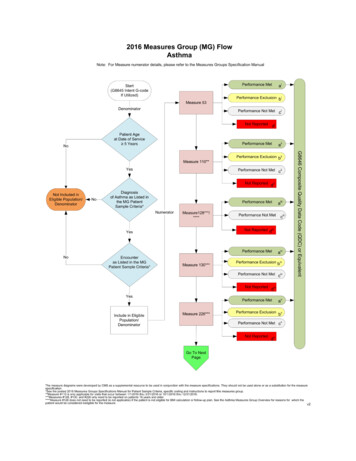
Transcription
THE AC-130 GUNSHIP AND ITS VARIANTSResearch from 10/2010
AC-130The AC-130 gun ship’s primary missions are close air support, air interdiction and armed reconnaissance. Other missionsinclude perimeter and point defense, escort, landing, drop and extraction zone support, forward air control, limitedcommand and control, and combat search and rescue.These heavily armed aircraft incorporate side-firing weapons integrated with sophisticated sensor, navigation and firecontrol systems to provide surgical firepower or area saturation during extended periods, at night and in adverse weather.The AC-130 has been used effectively for over thirty years to take out ground defenses and targets. One drawback tousing the AC-130 is that it is typically only used in night assaults because of its poor maneuverability and limitedorientations relative to the target during attack.During Vietnam, gun ships destroyed more than 10,000 trucks and were credited with many life-saving close air supportmissions. AC-130s suppressed enemy air defense systems and attacked ground forces during Operation Urgent Fury inGrenada. This enabled the successful assault of Point Saline’s airfield via airdrop and air land of friendly forces.The gunships had a primary role during Operation Just Cause in Panama by destroying Panamanian Defense ForceHeadquarters and numerous command and control facilities by surgical employment of ordnance in an urbanenvironment. As the only close air support platform in the theater, Spectres were credited with saving the lives of manyfriendly personnel. Both the H-models and A-models played key roles. The fighting was opened by a gunship attack on themilitary headquarters of the dictator of Panama and the outcome was never in doubt. All objectives were quicklyaccomplished and democracy was restored to Panama.During Operation Desert Storm, Spectres provided air base defense and close air support for ground forces. Both the AC130A and AC-130H gunships were part of the international force assembled in the Persian Gulf region to drive out ofKuwait which Saddam Hussein had invaded in early August 1990. In the following January, the allies launched the actualwar known as Desert Storm following the Desert Shield build-up. Victory was accomplished in a few weeks and Kuwaitwas set free of the foreign invader. Iraq shot down one AC-130H gunship. It resulted in the loss of all 14 crewmembers,the largest single air power loss of the war. Post war restriction on Iraq required the presence of gunships to enforcethem.AC-130s were also used during Operations Continue Hope and United Shield in Somalia, providing close air support forUnited Nations ground forces. The gunships played a pivotal role during operations in support of the NATO mission inBosnia-Herzegovina, providing air interdiction against key targets in the Sarajevo area.The Naval Surface Warfare Center, Dahlgren Division (NSWCDD), on behalf of Air Force Special Operations Command(AFSOC) requested information in 2005 that may lead to the acquisition and qualification of a family of 120mm mortarammunition for enhancing the AC-130 Gunship Lethality and Survivability. Sources Sought N00178-05-Q-1925 was posted
18 August 2005 to Federal Business Opportunities (FBO). NSWCDD and AFSOC are seeking information on any (guided orconventional) 120mm mortar round that is currently fielded, currently a Program of Record (POR), or technology matureenough to enter into an ACTD or similar demonstration.The 120mm mortar concept shall offer benefits to the AC-130 fleet through: Employment flexibility through use ofmunitions currently available; Greater lethality through more fragmentation weight and greater blast damage; Precisionstrike capability; Increased standoff range and attack altitude while maintaining responsiveness; Reduction in collateraldamage; and Reduction in danger close distance when supporting troops in contact.For the 105-mm gun, 100 rounds weighs 4200 lbs. The recoil load is about 10,900 lbs, with a gun Recoiling Weight of1,465 lbs. The muzzle pressure is 3,560 psi. It is a legacy system being phased out of the US Army inventory. There islittle guided technology ongoing. For the 120-mm mortar, 100 Rounds weighs 3200 lbs. This weapon has a recoil Load of 5,600 lbs with a gun weight of 1,315 lbs. The muzzle pressure is 1,620 psi. This is the leading FCS fire support weaponand the Stryker Brigade Combat Team fire support weapon. There is a lot of Guided Munitions development work ongoing.The different variantsAC-130A Spectre
The A-model gunship was the first AC-130 model. The aircraft is 97 feet 9 inches long and 38 feet 3 inches tall. It has awingspan of 132 feet 7 inches and a wing area of 1,745 sq. feet. Initially, the C-130 had a maximum speed of 384 mphand an un-refueled range of 2,450 miles with maximum load. However, with the aerial refueling modification, the rangefor the later model gunships was only limited by crew endurance.The high-wing design of this aircraft and its large capacity made it especially suited as a gunship. The first gunship, theAC-47, with low wings, reduced its field of fire. Having the guns below the wings eliminated the basic problem of the AC47. Also, the large C-130 could carry more ammunition for its heavier weapons. The AC-47 was equipped with three7.62mm mini-guns. In contrast the AC-130A carried 7.62mm and 20mm weapons; the AC-130H fired 20mm, 40mm and105mm guns; and the newest gunship, the AC-130U, is equipped with 25mm, 40mm and 105mm weapons.The C-130 gunship was a new weapon system in an old airframe. Therefore, there were a number of firsts that one modelor another chalked up for the gunship. Spectre was operationally tested at Eglin Air Force Base, Fla., from June toSeptember 1967. It initially deployed to Nha Trang, Republic of Vietnam Sept. 20, 1967, and flew its first combat missionSept. 27. Its first truck busting mission was flown Nov. 8, 1967, and all A-model gunships were assigned to Detachment 2,14th Commando Wing. In 1968, Det. 2 was assigned to the 8th Tactical Fighter Wing and became the 16th SpecialOperations Squadron. At that time the C-130A was renamed the AC-130A.Spectre suffered it first battle damage from anti-aircraft artillery Sept. 26, 1968. The sturdy C-130 returned to base. InDecember 1968, F-4 Phantoms first escorted the gunship in an effort to protect it from ground fire. However, the firstgunship was lost with two crewmembers May 24, 1969. One was killed when the gunship was hit and the other perishedwhen the plane crashed at home base. Five of the 18 gunships were shot down or crashed while serving in Vietnam. Agunship accomplished an unusual feat, May 8, 1969, when it shot down an enemy helicopter. Thus was born thenickname the "fabulous four engine fighter" to the chagrin of fighter pilots who where having few opportunities for air-toair kills. Firepower increased when the first 105mm cannon arrived for installation on the gunship Feb. 17, 1972. Theartillery piece was first used in combat March 1, 1972.The Air Force commemorated the end of an era 10 September 1995 with the retirement of the first C-130 aircraft to comeoff a production line. The aircraft, tail number 53-3129, went into production at the Lockheed Aircraft Co. in Marietta, Ga.,in 1953 and was the original prototype of what was to become a long line of C-130 Hercules aircraft designed and built byLockheed. The aircraft, affectionately dubbed "The First Lady," was one of five AC-130A gunship aircraft retired during anofficial ceremony. While the other four aircraft were sent to the Aerospace Marketing and Regeneration Center at DavisMonthan Air Force Base, the First Lady went on permanent display at the Eglin Air Force Base Armament Museum. The919th Special Operations Wing's gunships, all around 40 years old, had reached the age of mandatory retirement. Theonly other gunships in the Air Force inventory are employed by active-duty members at Hurl Burt Field, which has lessthan 20 gunships assigned.
AC-130H SpectreThe Vietnam-era AC-130E "Pave Spectre"was an improved version of the AC-130A"PAVE PRONTO" aircraft. The C-130E wasequipped with more powerful versions of theAllison T56 turboprop engines. The AC-130Ewas later upgraded to AC-130H standardsunder project "Pave Spectre II"The AC-130 is an excellent fire supportplatform with outstanding capabilities. Withits extremely accurate fire control system,the AC-130 can place 105mm, 40mm and25mm munitions on target with first roundaccuracy. The crew of these aircraft areextremely proficient working in militaryoperations in urban terrain [MOUT]environments. Many ground units havebegun to use Infra-red (IR) tape either asarm bands or sewn to the top of theirballistic helmet for marking troops andvehicles, especially when working with theAC-130. It only takes a very small piece of IRtape to be distinguished as friend or foe byan AC-130, and anything larger than a oneinch by one inch piece is going to white outa large portion of the monitor aboard theaircraft.Because of the hostage situation in Teheran,Iran, four H-model gunships of the 16th SOSflew nonstop from Hurl Burt Field toAnderson Air Force Base, Guam in 1979 andlater were part of the support force duringthe hostage rescue attempt in 1980.
However, weather and mechanical problems with helicopter forced the mission abort of this heroic effort. In October1983, the gunships of the 16th SOS played a very significant part in the rescue of American medical students on theisland of Grenada. Without the firepower of the AC-130Hs, the invasion of Grenada would have cost more American lives.From late December 1989 to early January 1990, 23 AF participated in the re-establishment of democracy in the Republicof Panama during Operation JUST CAUSE. Special operations aircraft included active and AFRES AC-130 Spectre gunships,EC-130 Volant Solo psychological operations aircraft from the ANG, HC-130P/N Combat Shadow tankers, MC-130E CombatTalons, and MH-53J Pave Low and MH-60G Pave Hawk helicopters. Spectre gunship crews of the 1 SOW earned the MackayTrophy and Tunner Award for their efforts.Both the AC-130A and AC-130H gunships were part of the international force assembled in the Persian Gulf region to driveout of Kuwait which Saddam Hussein had invaded in early August 1990. In the following January, the allies launched theactual war known as Desert Storm following the Desert Shield build-up. Victory was accomplished in a few weeks andKuwait was set free of the foreign invader. Sadly, the enemy shot down one AC-130H gunship. It resulted in the loss of all14 crewmembers, the largest singer air power loss of the war.In March 1994, the price of freedom and the high operations tempo was paid by a 16th Special Operations Squadron AC130H gunship, call sign Jockey 14. The aircraft was lost due to an in-flight explosion and ditching off the coast of Kenyawhile supporting Operation CONTINUE HOPE II in Somalia. Eight crewmembers were killed, while six survived.In April 1996, the aircraft participated in Operation ASSURED RESPONSE, which provided support to the emergencyNoncombatant Evacuation (NEO) of more than 2,100 US and foreign citizens from Monrovia, Liberia. Operating in a hostilefire environment, SOF personnel conducted dozens of rotary wing evacuation flights using MH-53Js and overhead firesupport sorties in AC-130H Spectres, often vectoring friendly aircraft through heavy small arms and rocket propelledgrenade fire.The AC-130H ALQ-172 ECM Upgrade installs and modifies the ALQ-172 with low band jamming capability for all AC-130Haircraft. It also modifies the ALQ-172 with engineering change proposal-93 to provide increased memory and flight linereprogramming capabilities. The Air Force [WR-ALC/LUKA] issued a sole source, fixed price contract, to InternationalTelephone & Telegraph (ITT) for development of low band jammer and subsequent production. Issue a competitive, firmfixed price contract for the Group A modifications (preparing aircraft to receive jammers).Currently funded weight reduction and center of gravity (CG) improvements to the AC-130H aircraft include: redesign of40mm and 105mm ammo racks using lighter weight materials; reverse engineering of 40mm and 105mm trainable gunmounts using lighter weight material; and removal of non-critical armor. These efforts are performed by a sole sourcecontract awarded to Rock Island Arsenal.
AC-130U Spooky
Continuing the distinguished combat history ofside-firing AC-130 gunships, the new AC-130USpectre gunship was fielded as a replacement forthe AC-130A aircraft and to supplement the AC130H gunship fleet. Its mission is to supportconventional and joint special operations forcesany time, any place. The AC-130U Gunshipprogram initially consisted of 13 [later 17] newLockheed C-130H airframes, modified by Boeing,which assumed responsibility for the AC-130Ucontract when it merged with the RockwellCorporation, the original contractor on theprogram. The modifications allow the aircraft toperform the full range of special operations andconventional gunships missions. It providessurgical firepower, night and adverse weatheroperations, and extended loiter time on target inSpecial Operations Forces (SOF) and conventionalroles. The AC-130U is named for the AC-47D andhas the "Spooky" nickname rather than the"Spectre" nickname used by all other AC-130gunships.The AC-130U was armed with a 25mm Gatling-gun (capable of firing 1800 rounds per minute), a single-barrel, rapid-fire40mm Bofors cannon, and a 105mm Howitzer. The AC-130U replaced the two 20mm cannon used on the AC-130H withone trainable 25mm cannon while retaining the other weapons. The AC-130U employs the latest technologies and canattack two targets simultaneously.The U-model gunship is one of the most complex aircraft weapon systems in the world today, containing more than609,000 lines of software in its mission computers and avionics systems. Although it still uses the venerable Lockheed C130 airframe, the AC-130U incorporates the latest sensor technology, along with an entirely new fire-control system, tosubstantially increase the gunship's combat effectiveness. The fire control system offers a dual-target attack capability,whereby two targets up to one kilometer apart can be simultaneously engaged by two different sensors, using twodifferent guns. All light-level television, infrared sensors, and the Hughes APQ-180 radar (also found on the F-15E StrikeEagle) provide night and adverse weather capability. The strike radar provides the first gunship capability for allweather/night target acquisition and strike.The AC-130U is an excellent platform for working at night. The pilots are proficient with NVGs and the AC-130 carriesvarious systems for working in the dark including FLIR, and LLTV. It has an LST and two laser designators, although these
systems cannot be cued to each other. The APQ-180 fire control radar gives the AC-130 an adverse weather capability.They orbit at approximately 5,000-10,000 AGL around a target area in a 5 nm arc. AC-130U strengths include an excellentloiter time of up to 4 ½ hours. It is a superior platform for Troops in Contact (TIC), and is best used at night to optimize allof its sensors. It also has a superior communications suite. AC-130U weaknesses include decreased maneuverability andsurvivability in a high tech surface-to-air threat environment. It is a large target with slow speed and should not be usedin a high threat environment in daylight. It also has a wide orbit pattern.All weapons can be slaved to sensors which permit night or adverse weather operations. The AC-130U is a highlyintegrated weapons system. Within the AC-130U resides the Battle Management Center (BMC) where crew coordination iscritical to the success of their missions. This BMC consists of five crew stations which are the Navigator (Nav), Fire ControlOfficer (FCO), Electronic Warfare Officer (EWO) and two Sensor Operators who control the Infrared Detection Set (IDS) andthe All Light Level Television (ALLTV) systems.To enhance survivability, emphasis has been placed on increasing the stand-off range of the gunship's weapons systemand improving first-shot accuracy. In addition, a set of electronic countermeasures has been installed to help defend theAC-130U against modern threats. The AC-130U gunship airframe is integrated with an armor protection system (APS).The 16th Special Operations Wing at Hurlburt Field received two AC-130U aircraft in mid-1996, giving the Wing a total of12 AC-130U aircraft. This resulted in an increase of 87 full-time military manpower authorizations.In August 1998 elements of the 4th Special Operations Squadron from a deployment in the Bosnia-Herzegovina area ofoperations. During the deployment, the AC-130U Spooky gunships, flown by the 4th SOS, completed more than 230flights, providing close air support, interdiction and reconnaissance for U.S. and NATO troops implementing the DaytonPeace Accords.Two 4 SOS AC-130U Spectre gunships arrived at Taegu AB, South Korea, 24 October 1997, following a 36-hour nonstopmission from Hurlburt Field, Florida. The mission brought members of the 4 SOS to participate in Foal Eagle 1997, anannual Joint Chiefs of Staff exercise held throughout South Korea. Members of the 6 SOS, the FID squadron, alsoparticipated.Throughout 1998 AFSOC maintained a constant CSAR alert posture as part of Operation JOINT GUARD, with aircraft andpersonnel rotating from the 16 SOW and 352 SOG to San Vito, Italy on a routine basis. This role increased significantly inMarch 1999 during the crisis in Kosovo and Operation ALLIED FORCE. Operation ALLIED FORCE witnessed the employmentof the AC-130U to provide armed reconnaissance. All told, AFSOC’s special operators and aircraft played a significant rolein bringing the conflict in Kosovo to an end.
EC-130
The Hercules probably is the most versatile tactical transport aircraft ever built. Its uses appear almost limitless: transportation,electronic surveillance, search and rescue, space-capsule recovery, helicopter refueling, landing (with skis) on snow and ice, gunship and special cargo delivery. It has even landed and taken off from a carrier deck without benefit of arresting gear or catapults.The EC-130E ABCCC consists of seven aircraft that are used as an Airborne Battlefield Command and Control Center. The EC-130E isa modified C-130 "Hercules"; aircraft designed to carry the USC-48 Airborne Battlefield Command and Control Center Capsules(ABCCC III). These one-of-a kind aircraft include the addition of external antennae to accommodate the vast number of radios in thecapsule, heat exchanger pods for additional air conditioning, an aerial refueling system and special mounted rails for uploading anddownloading the USC-48 capsule. The ABCCC has distinctive air conditioner intakes fore of the engines ("Mickey Mouse ears"), twoHF radio probes-towards the tips of both wings, and three mushroom-shaped antennas on the top of the aircraft - and, of course,numerous antennas on the belly.The EC-130E Commando Solo (initially known as Volant Solo) is available to commanders for localized targeting of specific avenuesof communication. The EC-130E exists in Comfy Levi and Rivet Rider versions. A multi-purpose asset capable of conducting bothPSYOP and EW, the EC-130E, Commando Solo, is an airborne platform "primarily designed for PSYOP." Commando Solo can conductpsychological broadcast missions in the standard AM, FM, HF, TV and military communications bands.In a congressionally directed program, aging EC-130Es are being replaced with new C-130Js, with the current mission equipmentbeing moved from the old aircraft to the new models.The EC-130H Compass Call is the only US wide-area offensive information warfare platform, Compass Call provides disruptivecommunications jamming and other unique capabilities to support the Joint Force Commander across the spectrum of conflict.Compass Call is the designation for a modified version of Lockheed corporation's C-130 Hercules aircraft configured to performtactical command, control and communications countermeasures or C3CM. Targeting command and control systems providescommanders with an immense advantage before and during the air campaign. COMPASS CALL provides a non-lethal means ofdenying and disrupting enemy command and control, degrading his combat capability and reducing losses to friendly forces.
EC-130E Commando Solo / Rivet RiderThe EC-130E Commando Solo (initially known as Volant Solo) isavailable to commanders for localized targeting of specific avenues ofcommunication. The EC-130E exists in Comfy Levi and Rivet Riderversions. Senior Hunter aircraft flying the SENIOR SCOUT missionsupport Commando Solo aircraft. A multi-purpose asset capable ofconducting both PSYOP and EW, the EC-130E, Commando Solo, is anairborne platform "primarily designed for PSYOP." Commando Solo canconduct psychological broadcast missions in the standard AM, FM, HF,TV and military communications bands. Missions in Bosnia were flownat maximum altitudes possible to ensure optimum propagationpatterns. Highly specialized modifications had been made to the latestversion of the EC-130E. These included enhanced navigation systems,self-protection equipment, and the capability of broadcasting color television on a multitude of worldwide standardsthroughout the TV VHF/UHF ranges.This weapon system is the mainstay information operations aircraft for peacekeeping and peacemaking operations andhumanitarian efforts which comprise a large percentage of today's military missions. Commando Solo conductspsychological operations and civil affairs broadcast missions in the standard AM, FM, HF, TV, and military communicationsbands. Missions are flown at the maximum altitudes possible to ensure optimum propagation patterns. The EC-130 flieseither day or night scenarios with equal success, and is air refuelable. A typical mission consists of a single-ship orbitwhich is offset from the desired target audience. The targets may be either military or civilian personnel. Secondarymissions include command and control communications countermeasures (C3CM) and limited intelligence gathering.With the capability to control the electronic spectrum of radio, television, and military communication bands in a focusedarea, the Commando Solo aircraft can prepare the battlefield through psychological operations and civil affairsbroadcasts. These modified C-130Es provide broadcasting capabilities primarily for psychological operations missions;support disaster relief operations; and perform communications jamming in military spectrum and intelligence gathering.One oversized blade antenna is under each wing with a third extending forward from the vertical fin. A retractable wireantenna is released from the modified beavertail, with a second extending from the belly and held vertical by a 500pound weight.Capabilities include:
Reception, analysis, and transmission of various electronic signals to exploit electromagnetic spectrum formaximum battlefield advantageSecondary capabilities include jamming, deception, and manipulation techniquesUnrefueled range 2800 NMBroadcasts in frequency spectrums including AM/FM radio, short-wave, television, and military command, controland communications channelsRivet Rider modification includes: VHF and UHF Worldwide format color TVInfrared countermeasures [chaff/flare dispensers plus infrared jammers]Vertical trailing wire antennaFire suppressant foam in fuel tankRadar warning receiverSelf-contained navigation systemThe modification added a pair of underwing pylon mounted 23X6 foot equipment pods, along with X-antennae mountedon both sides of the vertical fin. Six aircraft have been modified to the Rivet Rider configuration by the contractor,Lockheed Martin; Ontario, California.Commando Solo and Senior Scout operations may be long or short range missions with extended orbit delays planned atthe aircraft operating ceiling, and may require one or multiple air refuelings. Some missions may require a combat profile,with a low altitude profile enroute to the mission orbit area. The electronic environment may be hostile, with enemyability to jam all communications radios and electronic transmission systems; to intercept and use intelligenceinformation transmitted over nonsecure electronic systems and radios; and to pinpoint the position of the aircraftemitting any electronic transmission or signal.Commando Solo supported the operation JOINT GUARD mission by shutting down anti-SFOR propaganda through radioand TV broadcasts over Bosnia-Herzegovina in support of SFOR operations. Three Air National Guard EC130E CommandoSolo aircraft were deployed from the 193rd Special Operations Wing in Harrisburg, PA, to a base in Italy, an hour flightacross the Adriatic Sea from Sarajevo. This was a direct response to persistent hostile Bosnian-Serb radio and televisionpropaganda from the Karadzic faction. This same wing flew missions into Haiti during Operation UPHOLD DEMOCRACY tobroadcast messages under the call sign of Radio Democracy on one AM band and three FM bands.Operating from Brindisi, Italy, the Commando Solo EC-130Es were equipped with high-power transmitters for TV, AM, andFM radio broadcasting. The plane's EW capabilities also allowed it to operate as a jamming device. In this mode,Commando Solo had the potential to jam Bosnian-Serb hard-liners' television and radio broadcasts or simply overpowertheir signal and replace propaganda with PSYOP programs. When used to broadcast programming over the adversary
signal, the aircraft is performing a PSYOP function. The aircraft executed three test flights over Bosnia-Herzegovina inSeptember, testing radio broadcasting equipment as a non-violent "show of force" by SFOR.The show of force was in response to inflammatory anti-NATO and anti-SFOR propaganda broadcasted by Serbian RadioTelevision (SRT). SFOR had forcibly secured SRT transmitter towers in September 1997, returning them to SRT controlafter securing written assurances that the propaganda would stop, that more even-handed reporting would follow, andthat international programming on the progress of the peace operation would be aired. The SFOR commander warnedthat failure to follow through on these promises would result in decisive action by SFOR. Commando Solo gave SFOR thenon-lethal means of quickly neutralizing SRT transmissions in the case of non-compliance. The Commando Solosuccessfully relayed broadcast programs from the SFOR radio station "MIR" (Peace) without disruptions.In mid-October 1997, unidentified elements inside the Bosnian Serb Republic (Republika Serpska or RS) sabotagedtelevision transmitters, taking the legal government's programming off the air in much of the eastern part of the RS. Thepro-Karadzic faction resorted to propaganda to claim that the lack of normal programming was due to the "illegal" actionsof the Stabilization Force. Shortly afterwards, SFOR used Commando Solo in a live mission to transmit on a frequencynormally used by Bosnian Serb TV, actively countering the adversary propaganda by explaining that the absence ofnormal programming was due to the actions of the Bosnian-Serb leadership.EC-130J Commando Solo IIIn a congressionally directed program, aging EC130Es are being replaced with new C-130Js, withthe current mission equipment being moved fromthe old aircraft to the new models. Four aircrafthave been funded for delivery to the 193rd SpecialOperations Wing, Harrisburg, PA. The 193rd SOWnow flies eight 1960s-vintage EC-130Es that arenearing the end of their planned service life.Funding for one additional aircraft was needed as ofearly 2000 to complete the unit’s conversion andprevent leaving the unit with a mixed fleet of E andmodel aircraft. The conversion program, asplanned, will take four years to complete.The first C-130J to be converted into a CommandoSolo II psychological warfare aircraft was flown toJ
Palmdale, CA in early July 2000. Technicians there carry out the task of converting them into the Commando Solo IIplatforms. Once modifications are completed, the first EC-130J was delivered for operational service in mid-2001. Theremaining three C-130Js initially on contract for conversion were flown to Palmdale at six-month intervals.The broadcast equipment carried on board the 193rd Special Operations Wing's 1963 and 1964-vintage EC-130Es is up todate and was cross decked into the new EC-130Js. The "green" C-130Js are modified for aerial refueling and receive anupgraded electrical system. After that, up-to-date radio and television broadcast equipment and antennas on the currentEC-130E Commando Solo aircraft is cross-decked to the new EC-130Js.The EC-130J Commando Solo II aircraft is able to conduct airborne radio and color television broadcasting on anyfrequency and in any format anywhere in the world. Broadcasts from the aircraft are carried out in areas of military orpolitical unrest either to inform or influence both military and civilian personnel in the area.An Air Force special operations analysis concluded in 2000 recommended the Boeing 767-200 to replace the EC-130ECommando Solo. The 767 is 60 percent longer and has more than twice the range of the EC-130E. But Congress currentlyis focusing on continued work on the EC-130J Commando Solo II.SummarizedWhich type of AC-130/EC-130 are we dealing with and how we can tellIt cannot be the AC-130A because those were retired in 1995, due to a mandatory retirement policy for military planesreaching 40 years in service.we know that the AC-130 that’s flying above us, regularly fly’s missions at night and in cloudy/adverse weatherconditions, the only one capable of doing this most effectively would be the AC-130U spooky.After taking a deep look at the EC-130, we can see that it has capabilities to broadcast and jam signals such as radio,television, other
The A-model gunship was the first AC-130 model. The aircraft is 97 feet 9 inches long and 38 feet 3 inches tall. It has a wingspa










